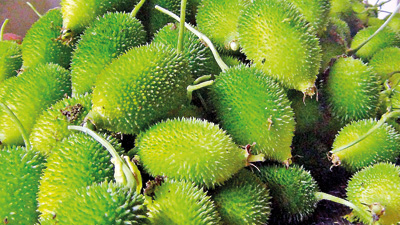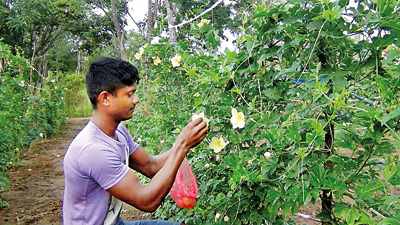News
Farmers savour sweet success with thumba karawila
Thumba Karawila may taste slightly bitter for some people, but this medicinal vegetable has brought sweet success to some 100 farmers in Anamaduwa and Mahakumbukkadawala.

The goodness of thumba karawila to be spread far and wide
Business is booming, say farmers who sell a kilo of thumba karawala at Rs. 150.
Thumba Karawila is known among villagers and ayurvedic physicians for its healing power for a variety of non-communicable diseases. Its botanical name is Momordica diocia. Called Vahisi and Karkufaki in Sanskrit; teasle gourd or spine gourd in English, it belongs to the ‘Kacurbitacease’ family.
There are about 60 varieties of this plant in the world. In Sri Lanka and India, thumba kiarawila has been popular and can be grown in both dry and wet zones.
In Sri Lanka, there had been about 19 varieties in the past, but now only nine varieties can be seen. But now both the Agrarian Department and the private sector are engaged in experimenting hybrid plants in their nurseries. Officials claim that these hybrid plants are 100 percent native and no foreign plants have been mixed.
Thumba karawila is rich in medicinal values and is being used in making ointments and syrups (Arishta) in Ayurvedic treatments. Many people cook this as a vegetable. With the right condiments and spices, it makes a tasty dish.
Agriculture official Jayantha Wanninyaka is keen on promoting thumba karawila cultivation and taking measures to introduce it as an export crop.
Mr. Wanninayake says, “Thumba cultivation has still not reached many farmers. So our aim is to make it more popular and help them get a good harvest while introducing it as an export produce.”
Farmer H.M. Asanka Ajith of Mahakumbukkadawala says that at the beginning the farmers were doubtful about its success. “We were not sure whether we could pollinate the male flowers with the female ones. But now we get up in the morning, pick the male plants and pollinate them. It has now become a daily routine. We are now getting a substantial income. Therefore, we can happily say it is a success.”

Giving nature a helping hand: A farmer engaged in the pollinating process
D.L.W. Rohini, another thumba karawila cultivator, says,”At first, we had second thoughts when we were asked to grow this plant. How could we grow a plant we had never grown before,we asked. But now despite many difficulties, we are going ahead with this successfully. Now we get Rs. 150 for a kilo. We hope to get a higher price soon with its popularity growing.”
Former G.S. A.H.M. Rathnamalala who took the initiatives to introduce it among his colleagues says he was working as parliamentarian Palitha Range Bandara’s project officer. It was in this capacity, he says he wanted to introduce a few crops. “It was during this time, I came to know Mr Wanninayake and together, we tried to introduce Thumba cultivation to our area farmers. I am happy, these farmers are now earning a good income,” he says, insisting that there is no politics in the effort. “Our efforts are aimed at helping the farmers and promoting this plant as an export crop.”

